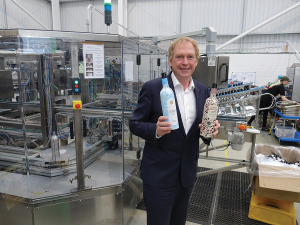One of the latest alternative packaging formats to emerge is the 'paper bottle', with a carbon footprint that's four times less than a lightweight glass bottle made in the United Kingdom.
The Frugal Bottle starts life as two flat pieces of recycled and chemical-free paperboard which are then formed around a traditional Bordeaux bottle mould with a food grade pouch, which is the same material used in bag-in-box wines.
Malcolm Waugh, Chief Executive of UK-based Frugalpac, says the bottle comes in at just 83 grams, which is five times lighter than a standard 440g glass bottle and four times lighter than a 345g lightweight alternative, "making it easier carry and lighter to transport".
Frugal Bottle was released in 2020 and is now available in New Zealand, engendering "an enormous amount of interest", starting with New Zealand gin start-up Mothers Ruined, which recently launched four new gins in the bottle. "Frugalpac also has enquiries to order seven million Frugal Bottles a year from New Zealand wine producers." They are working with Punch Bowl Packaging, which is considering an investment in the Frugal Bottle Assembly Machine so the bottles can be made in New Zealand. Malcolm says having locally produced bottles will cut the bottle's carbon footprint even further and allow wine producers to use local print and paper suppliers. "We will soon be able to provide a full end-to-end service in New Zealand from bottle production to filling, capping and packing." The food grade pouch is a polyethylene metallised polyester laminate, the same material used in bag-in-box wines. Launching a new format bottle amidst the Covid-19 pandemic did result on some "hesitancy" from traditional wine producers, Malcolm says. But in pre-launch polling 63% of wine drinkers said they would buy wine in a paper bottle, "so we knew the demand was there".
They now have more than 30 brands around the world using the Frugal Bottle for wines, spirits and olive oils, and at the 2023 ProWein wine fair in Germany, where eight wine and spirit brands were using paper bottles, journalists called it "increasingly ubiquitous".
"It's clear that the drinks industry has been wanting to make the move to more sustainable and lightweight packaging," Malcolm says. "We're getting inundated with enquiries now because we're offering them to join our paper bottle revolution."
Cradle to Grave
An independent life cycle analysis looked at the 'cradle to grave' life cycle of all bottles, including mineral extraction, manufacture, transportation, distribution, filling and recycling or incineration. Intertek tested the Frugal Bottle alongside bottles made from glass and PET plastic and found:
- The Frugal Bottle has the lowest carbon footprint with 91.9g CO2e - 84% lower than a 440g imported glass bottle (558.2g CO2e) and 34% lower than a bottle made from 100% recycled plastic (138.6g CO2e)
- The Frugal Bottle's water footprint is at least four times lower than glass. It takes 2.5 litres of water to make a lightweight 345g glass bottle made in the UK but only 0.6 litres to make a Frugal Bottle.





